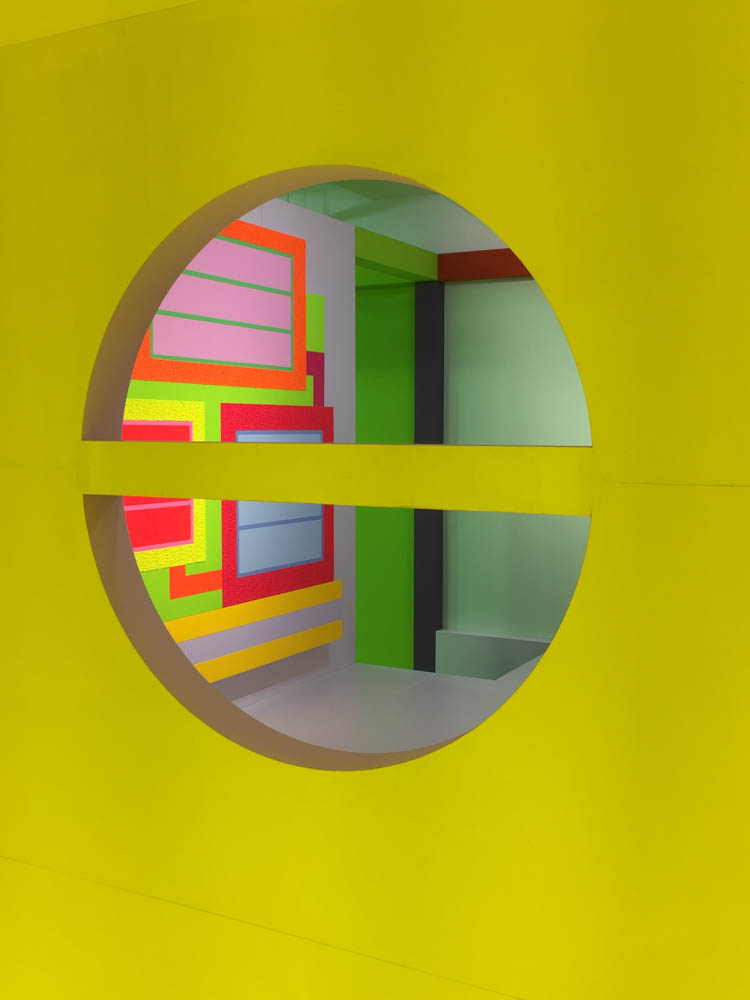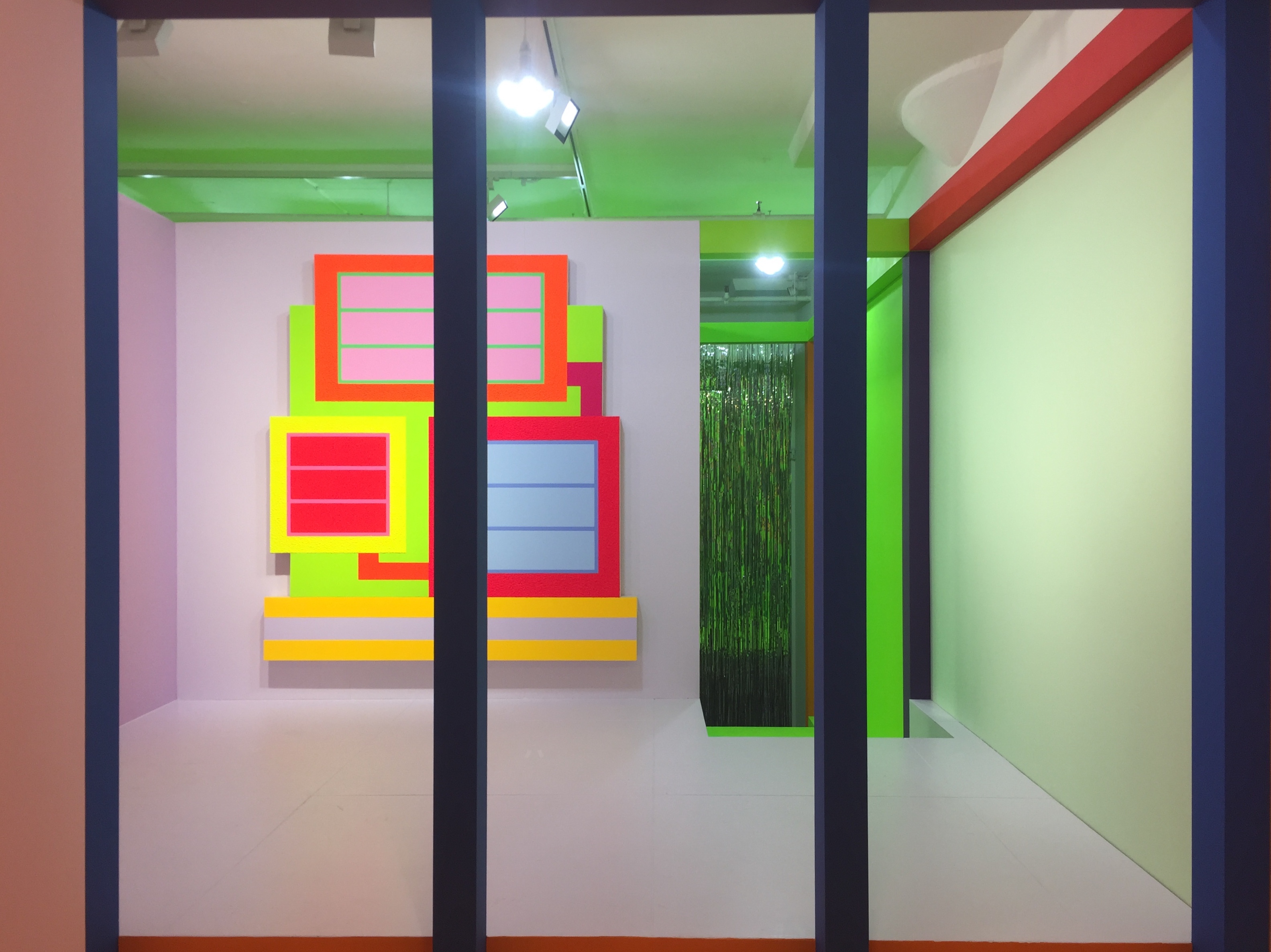Those two enclosing windows and the yellow stucco welcoming you at the entrance are really funny if you are an architecture nerd and get the reference; they evoke the roughness of Ronchamps’ béton brut façade with its enclosing windows. In fact, Halley has been using that same texture — cheap stucco — in his paintings since the beginning, in part to desacralize painting but also as a postmodern architectural reference; that of highway motels in the spirit of Learning from Las Vegas.

Halley has, all his life, been an architecture lover. He commissioned the first important home back in the 80s to the now renowned architect and dean of Yale Deborah Berke. All good architecture requires a good client, and I am sure that he was as much a client as a want-to-be architect already then. That house started her career. Then came collaborations with architects in buildings, like with Albalos y Herreros in their Library in Usera, Spain — that was also a ground-breaking project for the young Spanish couple (also architects). Then came Alessandro Mendini or Matali Crasset, both great architects and colourists themselves.

I believe it’s the architecture of the museum that forced him into the 3rd dimension. Since then, he has done one architectural intervention after another — Paris, New York, Venice - totally conquering space. Real artists never stop investigating, building on top of what they know and do. This is just a natural continuation of Halley’s life long investigation on colour, geometry and composition, also the architect’s tools.



Peter Halley’s Heterotopia I at the Magazzini del sale, presented by l’’Accademia di Belle Arti di Venezia, Venice and Flash Art.
There is also an unmistakable Luis Barragán reference in the installation, with the grid of square openings in green on one side and yellow on the other. Barragán is another modern architect who uses colour in the same constructive manner. Postmodern artist Peter Shire would call it: Mexican Bauhaus. The round window feels more post-modern than modern. Think of Venturi’s Lieb House, but it is more of a Louis Khan reference probably, he loved platonic forms and used the circle a lot (and Venturi worked with Khan for a while and was his TA at Penn) so that reference might be on a continuum… Austrian postmodern architect Hans Hollein (whose son totally by chance was the director of the Schirn when Halley appropriated it] is another reference here according to the press release, but I cannot elucidate it so easily, maybe the hairy silver back of the building? I am not sure…
Colour totally articulates the space in the same way it articulates the paintings. I feel that somehow, the artist has extrapolated his painting experience and approach to the application of colour to architecture. After all, as Hans Hollein famously said “Everything is architecture.” And Halley’s paintings definitely are.
 Installation view of Peter Halley’s Heterotopia II at Greene Naftali, New York, 2019
Installation view of Peter Halley’s Heterotopia II at Greene Naftali, New York, 2019
If we go now to the 8 paintings on view — named after imaginary planets from Isaac Asimov’s science-fictional universes — they are part of a recent investigation that started at his installation at the Lever House last winter, curated by Roya Sachs. That iconic modernist structure and childhood memory for Halley, who was born and grew up just few blocks away, as Park Avenue’s architecture was becoming corporate modernism, or “International Style” as they called it in the US — was the influence for him to decompose the canvas a step further, mirroring the building’s slab architecture. He always has worked with different rectangular canvases put together — his underground has always been a separate element of the above ground. He really sees his paintings as section cuts. The Lever House geometries inspired him to go one step further and treat every entity in the painting as a separate element; sometimes glued together with a free-floating background, which doesn’t obey contour anymore. Other times there is no background at all. As Halley moves more into architecture, so do his paintings.
To end I’d like to quote Warhol who was a large influence on Halley and whom critic John Russell called the Matisse of acrylics. I wrote somewhere else that if Warhol was indeed the Matisse of acrylics then Halley could be the Matisse after Warhol. Halley’s college thesis was actually on Matisse, and he lived for some 5 years in New Orleans, which he called his Cote d’Azur and which colourful landscape and architecture can’t be stressed enough as a very formative influence, as was Charles’ Moore Piazza d’Italia (one of the few icons of Postmodern architecture that isn’t a building) completed in 1978 when he was living there.
 Installation view of Peter Halley’s Heterotopia II at Greene Naftali, New York, 2019
Installation view of Peter Halley’s Heterotopia II at Greene Naftali, New York, 2019
Going back to Warhol — via Matisse and New Orleans — talking about the opening of his very cinematic shadow paintings of 1974, which he described as “Disco Decor.” Warhol was all about new media and the crosspollination of disciplines, as someone like Dick Higgins from FLUXUS theorized then under the label Intermedia. Postmodernism comes from those hybridizations. If the shadow paintings are like a large-scale celluloid film rendered in painting, creating literally also a colourful installation of sorts, in here Halley’s worlds of painting and architecture (instead of cinema) collide in what I now baptize Bauhaus Disco Decor.
 Installation view of Peter Halley’s exhibition New York, New York, at Lever House, New York.
Installation view of Peter Halley’s exhibition New York, New York, at Lever House, New York.
 Heterotopia II installation detail
Heterotopia II installation detail
 Heterotopia II installation detail
Heterotopia II installation detail
 Heterotopia II installation detail
Heterotopia II installation detail
 Heterotopia II installation detail
Heterotopia II installation detail
 Heterotopia installation detail
Heterotopia installation detail


